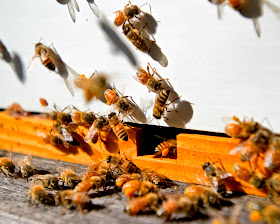Beeswax is an important product of the bee hive. This high-quality wax, secreted by young worker bees is the structure of the honey bees’ nest. Beeswax can be collected from old honeycomb or from the capping wax removed when extracting honey. The cappings are the beeswax seals the worker bees place over the cells holding fully ripened honey. Removing old comb is an effective way to remove absorbed environmental chemicals from the hives and reduce diseases spread by spores: American foulbrood, chalkbrood, and Nosema. At Peace Bee Farm, we consider replacement of old honeycomb an important part of our integrated pest management program. Since we don’t use chemicals in the hives, the capping wax that we save can be used to produce new frames of chemical-free honeycomb. Nanda Uganda asked about processing beeswax. To obtain the beeswax we paint onto plastic foundation, we take our capping wax and heat it in a wax melter. The capping wax, which contains a small amount of honey, melts around 145 degrees Fahrenheit. This honey can be recovered when the wax melts, but honey is altered in color, aroma, and flavor by temperatures above 120 degrees. The melted beeswax and heated honey flow from the wax melter into a separator, a simple container with a baffle. The beeswax floats atop the honey. When the beeswax cools and solidifies, thick residue, called slumgum, can be scraped away. To further purify the beeswax, it is melted several times in water. The water absorbs soluble impurities in the beeswax; insoluble material is strained from the beeswax. Repeating the process refines the beeswax.
We use beeswax primarily to coat frames for the brood nest and honey supers of our bee hives. Other uses include candle making as well as a number of bee hive products: hand and skin creams and lotions, lip gloss, soaps, furniture polish, and leather conditioners. People who sew use beeswax to strengthen their thread, and archers coat their bowstrings with beeswax.
--Richard






























